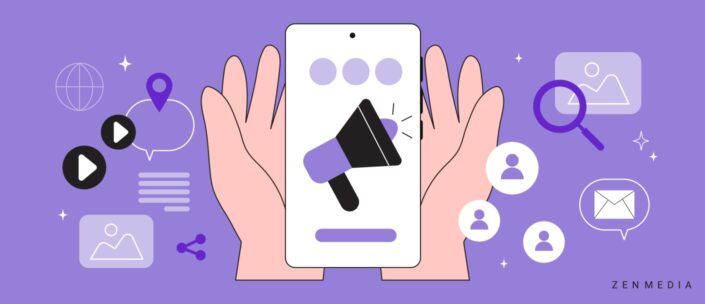Targeted ads, curated algorithms, neverending notifications.
This is the current state of our digital lives, and as B2B marketers, it can seem daunting to figure out how to successfully cut through the noise.
In an age where consumers are constantly bombarded with information, understanding their journey from awareness to decision-making is critical to standing out against the competition.
With three key stages of customer awareness, the journey cycles through awareness, consideration, and decision. And by understanding the importance of optimizing and maintaining a balanced B2B content marketing strategy, businesses will be able to attract and convert customers–regardless of where they are in their purchasing journey.
Understanding the Dark Social Model
Before diving into how B2Bs can optimize their content, marketers need to understand the buyer journey. Put yourself in your customers’ shoes and think back to a time when your business had to make a purchasing decision.
What did that process look like for you? Did you immediately know what you wanted, or did you spend some time thinking about your options, conducting online research, and speaking to peers about the best possible solution? How many different providers did you speak with? Were you drawn in by targeted paid ads, or did you read high-ranking articles? How many different websites did you visit? Did you look at social media sites as well?
With so much information available, buyers are constantly researching, so the customer journey isn’t linear. In fact, it’s more of a circular process that starts with triggers and moves buyers from one point of exposure, interaction, or decision-making to the next before landing on a purchase. This is called the “messy middle.”
For Google, this diagram looks like an infinity loop with a trigger point at the top and a purchase point at the bottom. We at Zen Media have taken that loop and fleshed it out a bit to leave more room for the actual mess in the middle. We call this the Dark Social Model.
Meet in the Messy Middle
The messy middle is important in our diagram because it shows where shared, paid, earned, and owned media meet to interact with the consumer. It now takes at least 27 touchpoints for consumers to make a purchase decision, and the unquantifiable, untrackable area called dark social is where that activity occurs.
We define dark social as the activity and conversations that occur on social media in untrackable or non-public settings. This includes instances where customers read without commenting or liking, conversations between peers and friends in DMs or in private groups or networks, and other untrackable activities. This is also the center of your potential buyer’s purchase journey, where the bulk of the action takes place.
While it may seem like this is an uncontrollable part of the purchasing process, it’s actually an opportunity for you to make your mark and leave a variety of dazzling impressions through frequency bias. By strategically targeting potential buyers with paid, owned, shared, and earned media, your brand will become more noticeable during the critical exploration and evaluation phases of the buyer’s journey. This will help you create a positive impression that may lead a buyer to convert.
Audit Your Content
Since buyers spend the bulk of their journey in the messy middle, ensure your brand is reaching them at every possible touch point. Your brand’s combined efforts of paid, earned, shared, and owned media work together to build awareness before a customer even begins to think about buying with the goal of having a customer remember your name or recognize your logo once they embark on their journey. This will keep you at the forefront of their mind throughout the buying process.
As you review your B2B marketing strategy, begin by conducting a content audit. Consider the following: What types of content do you have a lot of? What types of content are you lacking in? What additional content can be helpful? How can you make your content more appealing? Which personas are you targeting, and which ones are you overlooking?
Conducting a thorough content audit will reveal important information about where your brand is and where it needs to be. It can identify gaps in your content strategy and provide a guide as you work on making improvements.
Here are a few tips to help you conduct a thorough content audit:
- Speak to customers directly. Conduct surveys or sales calls with current and prospective customers to get an idea of their pain points and gain an understanding of the information they need from you.
- Don’t overlook SEO. To succeed, you need to implement SEO best practices, and in our rapidly changing world, this area requires frequent attention. An SEO audit will reveal barriers to ranking higher in searches. Use them to improve your website’s searchability and search rankings.
- Perform regular social media audits. With an emphasis on short-form content, social media can be more casual than something you would find on a brand website, but it’s also an important tool to introduce your brand to potential customers. Ensure your social channels provide a wealth of information by sharing helpful links and graphics. Take this time to evaluate your tone as well. An upbeat, informative voice will draw positive attention while using too much industry jargon might turn people away.
- Review your website. A powerful tool for sharing information, websites allow you to publish a variety of content and increase your chances of reaching the right audience. This includes blog posts, white papers, infographics, and videos discussing the same topics. Sharing the same information in new ways will reach more people and underscore your knowledge in the space.
- Know your audience. What does your ideal customer look like? Are you reaching the right audience? Once you understand your buyer, you can curate your content to draw them in and keep them coming back to your brand. This includes knowing the best channels to reach customers and offering a steady stream of relevant content.
Related Reading: The Ultimate Guide to Content Marketing for B2B
Balance is Key
Once complete, the audit will reveal which areas are lacking and which ones have too much content. This is your opportunity to balance your content and ensure greater success. Align your content with the appropriate buyer personas to maintain a balance of content types and diversify your outreach to reach a variety of potential customers.
Consider drafting blog posts to explain your products and services, use targeted social ads to reach a specific audience, and look into adding more audio and video content to add dimension to your content. It’s also important to find ways to add your brand’s unique voice and style to your content and identify key differentiators from the competition.
This will likely require a lot of time spent modifying your content until you strike the perfect balance of sharing helpful information to the right audience with the right style that matches your brand best, but this discovery phase is important to the overall customer journey.
Once established, this balance is what drives visitors to your site and converts them into customers. It piques interest on your social channels and leads to inquiries. It builds trust and loyalty, hopefully earning you a customer for life.
As customers wade through a seemingly endless stream of content throughout their buyer journey, your brand should stand out as a strong, consistent presence that remains in their line of vision.
Improving and building a robust content strategy begins by understanding the customer journey, auditing content, and filling in the gaps where necessary. Once established, your brand will appear at various key points throughout the buyer journey, drawing a map from the customer to you through awareness, consideration, and conversion.
Are you ready to improve your content strategy and increase your customer awareness? Get in touch.







